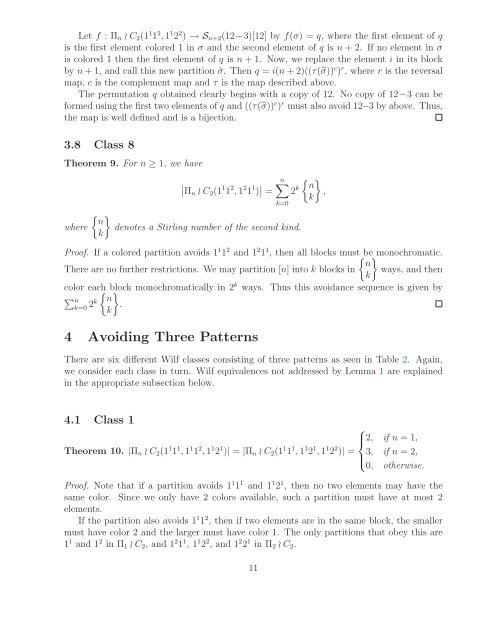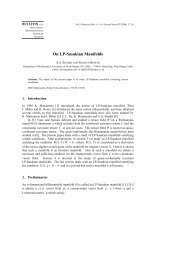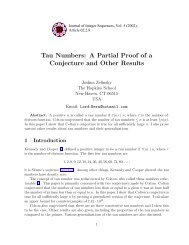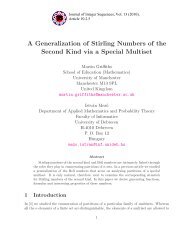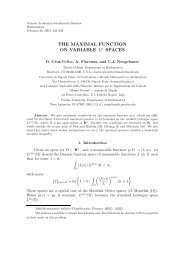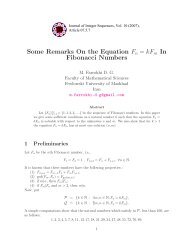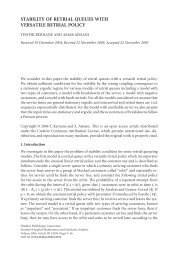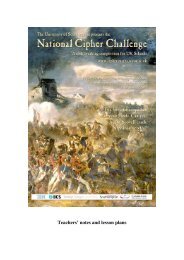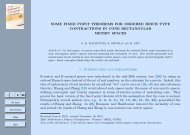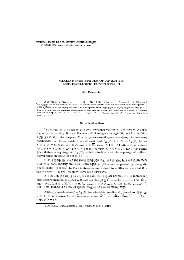Suppose, now that j ≠ n is <strong>the</strong> first element colored 2. As above, <strong>the</strong> elements less than jmust all be colored 1 and j may not appear <strong>in</strong> a block with any <strong>of</strong> <strong>the</strong> elements preced<strong>in</strong>g j.If an element follow<strong>in</strong>g j appeared <strong>in</strong> a block with an element preced<strong>in</strong>g j <strong>the</strong>n that elementis colored 1 or 2. If it is colored 1, it creates a copy <strong>of</strong> 1 2 2 1 with j. If it is colored 2 <strong>the</strong>nit creates a copy <strong>of</strong> 1 1 1 2 with an element appear<strong>in</strong>g before j. Thus, none <strong>of</strong> <strong>the</strong> elementsfollow<strong>in</strong>g j may appear <strong>in</strong> a block with an element preced<strong>in</strong>g j. We may partition <strong>the</strong>se j −1elements any way we like.We now turn to <strong>the</strong> n − j elements follow<strong>in</strong>g j. None <strong>of</strong> <strong>the</strong>se elements could appear <strong>in</strong><strong>the</strong> block with j <strong>in</strong> which case <strong>the</strong>re are B(n − j) ways to partition <strong>the</strong>m, and <strong>the</strong>y must allbe colored 2 to avoid 1 2 2 1 .Suppose <strong>the</strong>re are k ≥ 1 <strong>of</strong> <strong>the</strong> elements {j + 1,...,n} <strong>in</strong> <strong>the</strong> same block as j. If one <strong>of</strong><strong>the</strong>m is colored 1 <strong>the</strong>n to avoid 1 2 2 1 <strong>the</strong>se k elements must be j + 1,j + 2,...,j + k. Now,<strong>the</strong>re are k ways to pick <strong>the</strong> smallest <strong>of</strong> <strong>the</strong> elements j + 1,...,j + k to be colored 1, and atthis po<strong>in</strong>t <strong>the</strong> colors on <strong>the</strong>se elements are determ<strong>in</strong>ed. If none <strong>of</strong> <strong>the</strong>se k elements is colored1 <strong>the</strong>n we may choose <strong>the</strong>m <strong>in</strong> ( )n−jk ways. Once we have added <strong>the</strong>se k elements to <strong>the</strong>block conta<strong>in</strong><strong>in</strong>g j we partition <strong>the</strong> rema<strong>in</strong><strong>in</strong>g elements <strong>in</strong> B(n −j −k) ways and color <strong>the</strong>m2. This gives us <strong>the</strong> last term above.3.7 Class 7Theorem 8. For n ≥ 1, we have∣ Πn ≀ C 2 (1 1 1 2 , 1 1 2 2 ) ∣ ∣ = (n + 1)B(n).Pro<strong>of</strong>. Suppose σ ∈ Π n ≀ C 2 (1 1 1 2 , 1 1 2 2 ), and suppose i is <strong>the</strong> smallest element colored 1.Every element larger than i must be colored 1 as well. By assumption everyth<strong>in</strong>g preced<strong>in</strong>gi must be colored 2. There are no restrictions on how <strong>the</strong>se elements may be partitioned, sowe partition <strong>the</strong>m <strong>in</strong> B(n) ways. We can choose <strong>the</strong> i above <strong>in</strong> n + 1 ways, where i = n + 1corresponds to <strong>the</strong> whole partition colored 2.The above pro<strong>of</strong> is purely enumerative, but we also provide a bijective pro<strong>of</strong>. It is knownvia OEIS entry A052889 that (n+1)B(n) counts <strong>the</strong> number <strong>of</strong> elements <strong>in</strong> S n+2 (12−3)[12],where S n+2 (12−3)[12] is <strong>the</strong> set <strong>of</strong> permutations avoid<strong>in</strong>g <strong>the</strong> pattern 12−3 and beg<strong>in</strong>n<strong>in</strong>gwith a copy <strong>of</strong> 12. Notice that <strong>the</strong>se permutation must have n + 2 as <strong>the</strong>ir second element.The first element may be anyth<strong>in</strong>g. The rema<strong>in</strong><strong>in</strong>g n elements must form a 12−3 avoid<strong>in</strong>gpermutation.Alternate Pro<strong>of</strong> <strong>of</strong> Theorem 8. We make use <strong>of</strong> a bijection <strong>of</strong> Claesson [1] that puts S n (1−23)<strong>in</strong> bijection with Π n . Let σ = B 1 /B 2 /.../B k ∈ Π n . Order <strong>the</strong> blocks so that m<strong>in</strong>B 1 >m<strong>in</strong> B 2 > · · · > m<strong>in</strong> B k . Order <strong>the</strong> elements with<strong>in</strong> <strong>the</strong> blocks so that <strong>the</strong> first element <strong>in</strong> eachblock is <strong>the</strong> m<strong>in</strong>imum element <strong>in</strong> that block and <strong>the</strong> rema<strong>in</strong><strong>in</strong>g elements are <strong>in</strong> decreas<strong>in</strong>gorder. Claesson shows that <strong>the</strong> map τ(σ) = B 1 B 2 ...B k , where <strong>the</strong> blocks are concatenatedis a bijection between Π n and S n (1−23).10
Let f : Π n ≀ C 2 (1 1 1 2 , 1 1 2 2 ) → S n+2 (12−3)[12] by f(σ) = q, where <strong>the</strong> first element <strong>of</strong> qis <strong>the</strong> first element colored 1 <strong>in</strong> σ and <strong>the</strong> second element <strong>of</strong> q is n + 2. If no element <strong>in</strong> σis colored 1 <strong>the</strong>n <strong>the</strong> first element <strong>of</strong> q is n + 1. Now, we replace <strong>the</strong> element i <strong>in</strong> its blockby n + 1, and call this new partition ˆσ. Then q = i(n + 2)((τ(̂σ)) c ) r , where r is <strong>the</strong> reversalmap, c is <strong>the</strong> complement map and τ is <strong>the</strong> map described above.The permutation q obta<strong>in</strong>ed clearly beg<strong>in</strong>s with a copy <strong>of</strong> 12. No copy <strong>of</strong> 12−3 can beformed us<strong>in</strong>g <strong>the</strong> first two elements <strong>of</strong> q and ((τ(̂σ)) c ) r must also avoid 12−3 by above. Thus,<strong>the</strong> map is well def<strong>in</strong>ed and is a bijection.3.8 Class 8Theorem 9. For n ≥ 1, we have∣∣Π n ≀ C 2 (1 1 1 2 , 1 2 1 1 ) ∣ ∣ =n∑{ } n2 k ,kk=0{ nwhere denotes a Stirl<strong>in</strong>g number <strong>of</strong> <strong>the</strong> second k<strong>in</strong>d.k}Pro<strong>of</strong>. If a colored partition avoids 1 1 1 2 and 1 2 1 1 , <strong>the</strong>n all blocks must{ be monochromatic.nThere are no fur<strong>the</strong>r restrictions. We may partition [n] <strong>in</strong>to k blocks <strong>in</strong> ways, and <strong>the</strong>nk}color each { block } monochromatically <strong>in</strong> 2 k ways. Thus this avoidance sequence is given by∑ n nk=0 2k .k4 <strong>Avoid<strong>in</strong>g</strong> Three <strong>Pattern</strong>sThere are six different Wilf classes consist<strong>in</strong>g <strong>of</strong> three patterns as seen <strong>in</strong> Table 2. Aga<strong>in</strong>,we consider each class <strong>in</strong> turn. Wilf equivalences not addressed by Lemma 1 are expla<strong>in</strong>ed<strong>in</strong> <strong>the</strong> appropriate subsection below.4.1 Class 1⎧⎪⎨ 2, if n = 1,Theorem 10. |Π n ≀ C 2 (1 1 1 1 , 1 1 1 2 , 1 1 2 1 )| = |Π n ≀ C 2 (1 1 1 1 , 1 1 2 1 , 1 1 2 2 )| = 3, if n = 2,⎪⎩0, o<strong>the</strong>rwise.Pro<strong>of</strong>. Note that if a partition avoids 1 1 1 1 and 1 1 2 1 , <strong>the</strong>n no two elements may have <strong>the</strong>same color. S<strong>in</strong>ce we only have 2 colors available, such a partition must have at most 2elements.If <strong>the</strong> partition also avoids 1 1 1 2 , <strong>the</strong>n if two elements are <strong>in</strong> <strong>the</strong> same block, <strong>the</strong> smallermust have color 2 and <strong>the</strong> larger must have color 1. The only partitions that obey this are1 1 and 1 2 <strong>in</strong> Π 1 ≀ C 2 , and 1 2 1 1 , 1 1 2 2 , and 1 2 2 1 <strong>in</strong> Π 2 ≀ C 2 .11


